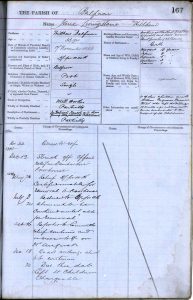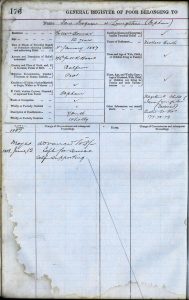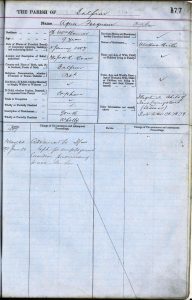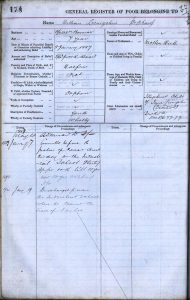On the 20th December 1886, the four Livingstone children living in Balfron were made orphans when their mother died. Jane Livingstone was a single mum who was raising her children with no support from family. She was employed at the local shirt factory and supplemented this income by ‘finishing’ shirts at home, that is, sewing on buttons, removing any thread ends, pressing and folding ready for sale. Jane suffered ill health, possibly from a recurring illness such as tuberculosis, which was extremely common at this time. She struggled to make ends meet, despite working, because she had been abandoned by her partner in 1882 and had 5 children living at home as follows: –
- Margaret, born c.1871
- Jean or Jane, born c.1875
- Agnes, born c.1878
- William, born c.1880
- James or Jessie, born c.1881
We know so much about Jane and her family because she applied to Balfron Parochial Board for help with maintaining her children in November 1883, a year after William Ferguson, her partner, left her. When someone applied to the Parish authorities for help, all their details were recorded in the register of the poor and these records are a wonderful source of information about people’s lives.
After their mother died, the children were entirely dependent on the Parish authorities for their support and so their details were entered separately into the register of the poor. Each child has their own page giving details of their age and background, their connection to their siblings and what happened to them after the death of their mother.
It looks as if the eldest child, Margaret, had left home before Jane’s death as she does not appear in the register at all. This is quite likely as she would have been 15 by 1887, and most children began work sometime between 12 and 14 at this time, depending on the occupation.
The Balfron register of the poor allows us a glimpse into the life of this late Victorian family. Many details are here that would not be available from any other source, some are, tantalisingly, missing. Further research in other records would allow us to follow up what happened to these children as they grew up in the early 20th century.
Jane, (given as ‘Jean’ in her mother’s record) who was 12 when her mother died, lived with her siblings in foster care with a Mrs Bonnar in Balfron until she was 14 in 1888 when she ‘left for service’, that is, became a domestic servant. It is quite likely that this would not be locally but in Glasgow as there were more opportunities in the city for this kind of work.
Agnes remained in foster care until 1890 when she ‘left for employment’ the occupation is not specified in the record. She would have been 12.
William appears to have been in some trouble when he was 9 years old as he is described as being ‘committed before the Justice of Peace Court this day to the Industrial School, Stirling’ on the 7th January 1889. Industrial Schools were set up to provide correction for children who were causing problems by their behaviour. The intention was to stop children from turning to crime and prevent them being exploited by criminal adults. William left the Stirling school in 1894 when he was 14 and is described as having ‘learned the trade of a tailor’.
Jessie (given as ‘James’ in her mother’s record; she was only 1 at this point and the Inspector of the Poor may have misheard or made a mistake about the sex of Jane’s youngest child) continued to be supported by the parish until she was 13, in 1894, when the payments for her were stopped because she was regarded as old enough to work. Unfortunately, the record does not say what happened to her after this but one can assume that she found employment either as a ‘mill girl’ like her mother or in service like her sister Jane.




